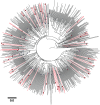Transmitted HIV Drug Resistance Is High and Longstanding in Metropolitan Washington, DC
- PMID: 27307507
- PMCID: PMC4996138
- DOI: 10.1093/cid/ciw382
Transmitted HIV Drug Resistance Is High and Longstanding in Metropolitan Washington, DC
Abstract
Background: Washington, DC, has 2.5% human immunodeficiency virus (HIV) prevalence, 3.9% among African Americans. Antiretrovirals (ARTs) are the cornerstone for treatment and prevention. Monitoring changes in transmitted drug resistance (TDR) is critical for effective HIV care.
Methods: HIV genotype data for individuals enrolled in research studies in metropolitan Washington, D.C., were used to identify TDR using the World Health Organization mutation list [Bennett DE, Camacho RJ, Otelea D, et al. Drug resistance mutations for surveillance of transmitted HIV-1 drug-resistance: 2009 update. PloS One 2009; 4:e4724]. HIV phylogenies were reconstructed using maximum likelihood and Bayesian methods. HIV transmission clusters were supported by 1000 bootstrap values >0.70 and posterior probability >0.95 of having a common ancestor.
Results: Among 710 individuals enrolled in 1994-2013, the median age was 38.6 years, 46.2% were female, and 53.3% were African-American. TDR was 22.5% among 566 treatment-naive individuals; 15.8% had nucleoside/nucleotide reverse transcriptase inhibitor (NRTI) resistance, 9.8% had nonnucleoside reverse-transcriptase inhibitor (NNRTI) resistance, and 4.2% had protease inhibitor (PI) resistance. Single class TDR was 10.0%, 5.1%, and 1.6% to NRTIs, NNRTIs, and PIs. Dual TDR to PI and NRTI was seen in 1.6%, NRTI and NNRTI in 3.4%, and triple class TDR in 0.9%. TDR frequency decreased from 1994-2006 (27.1%) to 2007-2013 (19.4%; P = .02). Only 6/79 (7.6%) individuals within transmission clusters had evidence of TDR.
Discussions: We identified high prevalence of TDR among HIV-infected individuals in metropolitan Washington, DC, regardless of gender. Active surveillance for TDR is needed to guide ART usage and analyses of risk group contributions to HIV transmission and resistance.
Keywords: HIV; HIV clusters; transmission dynamics; transmitted drug resistance; women.
© The Author 2016. Published by Oxford University Press for the Infectious Diseases Society of America. All rights reserved. For permissions, e-mail journals.permissions@oup.com.
Figures



References
-
- District of Columbia DoHHA, hepatitis, STD, and TB administration (HASTA). Annual epidemiology and surveillance report: surveillance data through December 2013, 2015.
Publication types
MeSH terms
Substances
Grants and funding
- P30 AI087714/AI/NIAID NIH HHS/United States
- KL2 TR000102/TR/NCATS NIH HHS/United States
- UL1 TR001409/TR/NCATS NIH HHS/United States
- KL2 TR001432/TR/NCATS NIH HHS/United States
- P30 AI117970/AI/NIAID NIH HHS/United States
- U01 AI034994/AI/NIAID NIH HHS/United States
- U01 AI069503/AI/NIAID NIH HHS/United States
- KL2 RR031974/RR/NCRR NIH HHS/United States
- HHSN261200800001C/RC/CCR NIH HHS/United States
- R01 AI068581/AI/NIAID NIH HHS/United States
- UM1 AI068634/AI/NIAID NIH HHS/United States
- U01 AI069494/AI/NIAID NIH HHS/United States
- HHSN261200800001E/CA/NCI NIH HHS/United States
LinkOut - more resources
Full Text Sources
Other Literature Sources
Medical
Research Materials
Miscellaneous

